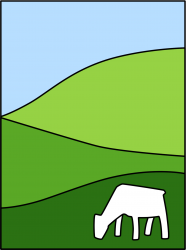ACCOUNTING FOR LIVESTOCK – PART 2
By David Russell, Spring 2006
In simple terms, if we have more livestock on hand at the end of this financial year (compared to last financial year) we will generally have some additional taxable income. We also have to take into account the valuation method used for the livestock because that too will impact on total taxable income for the year.
The basic concept is that an overall increase in the total value of livestock on hand from one year to the next will be taxable income, but this concept may be partly offset by the valuation method – in particular, the use of the Herd scheme method of valuation.
Income Tax Implications
Under the Herd scheme any changes in the valuation of the livestock are ignored for tax purposes. If Herd scheme values increase, we revalue upwards tax free; if Herd scheme values fall, we revalue downwards non tax deductible.
For example, say a farmer owned 200 mixed age Friesian cows at May 31 2005. The Herd scheme value for those animals that year was $1,071 per head. The herd would have had a total tax book value of $214,200 (200 x $1,071). For the year ended May 31 2006 the Herd scheme value increased to $1,187 per head for mixed age Friesian cows. If we still have a net 200 on hand at balance date the total herd will have a tax book value of $237,400 (200 x $1,187). The overall increase of $23,200 is tax free.
If the Herd scheme values reduce to (say) $1,050 per head in 2007, the revised value of the herd will be $210,000 (200 x $1,050). The devaluation of $27,400 in that year will be non tax deductible.
The net effect of using the Herd scheme method of valuation is that the value of the herd moves up and down on a tax free/non tax deductible basis over the years and (in theory) there should be no tax to pay on the herd when the farmer cash up and retires, because the tax book value of the whole herd should be fairly much in line with the final selling price.
We then need to consider the effect of increasing herd numbers. If we breed up some additional stock and increase the herd to 210 head, we will have to account for taxable income on the additional numbers of livestock on hand.
Choice
We have a choice of valuation methods for those 10 additional animals. We could add them to the Herd scheme stock giving them a value of $1,187/head. This would mean extra taxable income of $11,870 as a result of the extra livestock on hand at the end of the year.
Alternatively, we could value them using another valuation method, such as national standard cost (NSC). The NSC valuation would probably work out at about $750 per head so the extra taxable income on the additional 10 cows would be $7,500:
Tax on an extra $11,870 at 33% = $3,917
Tax on an extra $7,500 at 33% = $2,475
The net effect then is that there is a tax cost in adding livestock to the Herd scheme, i.e. you pay the extra tax now rather than paying it many years later when you cash up and retire.
You have to balance that extra tax cost now against the benefits of future tax free revaluations under the Herd scheme.
We strongly suggest that you:
– Do not add extra animals to the Herd scheme when values are high.
– Only add animals to the Herd scheme when values are low.
Only add animals to the Herd scheme when you expect significant inflation in future Herd scheme values.
